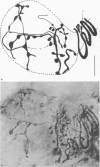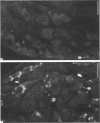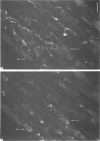Abstract
1. A slow synaptic potential recorded in neurones of sympathetic ganglia of bullfrog, the late slow e.p.s.p., is probably mediated by a peptide resembling luteinizing hormone-releasing hormone (LHRH), because (1). a LHRH-like peptide is contained in preganglionic nerve terminals and is released upon nerve stimulation, (2) application of LHRH to ganglion cells mimics the effects of the natural transmitter for the late slow e.p.s.p., and (3) the pharmacological properties of LHRH and the natural transmitter for the late slow e.p.s.p. are similar. 2. Neurones in frog sympathetic ganglia are also depolarized by substance P. The substance P receptors, unlike the LHRH receptors or the post-synaptic receptors for the late slow e.p.s.p., are not blocked by antagonist of LHRH. No cross-desensitization was found between the substance P-induced response and the LHRH-induced response or the late slow e.p.s.p. 3. Substance P-like immunoreactivity is contained in bundles of axons passing through the ganglia. This distribution is distinct from the distribution of LHRH-like immunoreactivity in preganglionic nerve terminals. Thus, substance P receptors and substance P-containing fibers are distinct from the post-synaptic receptors and preganglionic fibers responsible for the late slow e.p.s.p. 4. Physiological and anatomical evidence is presented which indicates that the peptidergic transmitter for the late slow e.p.s.p. can diffuse for many micrometres before acting on ganglion cells.
Full text
PDF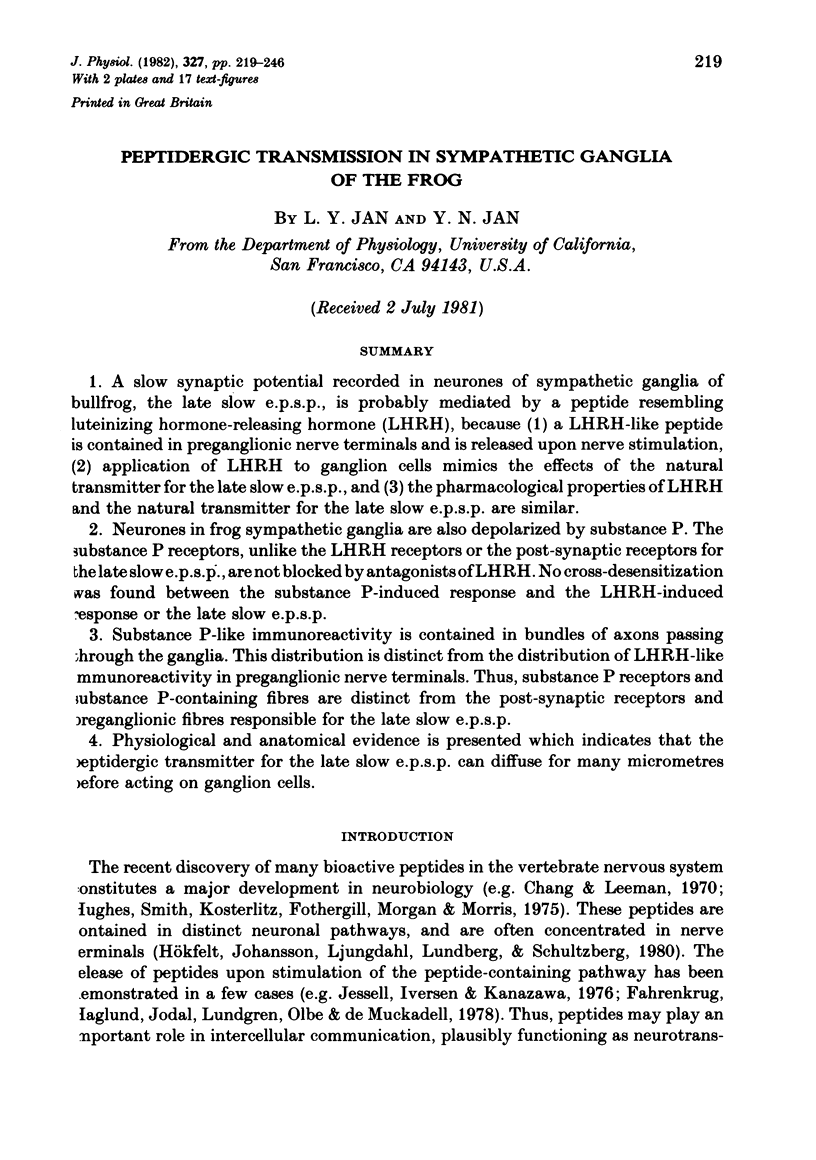
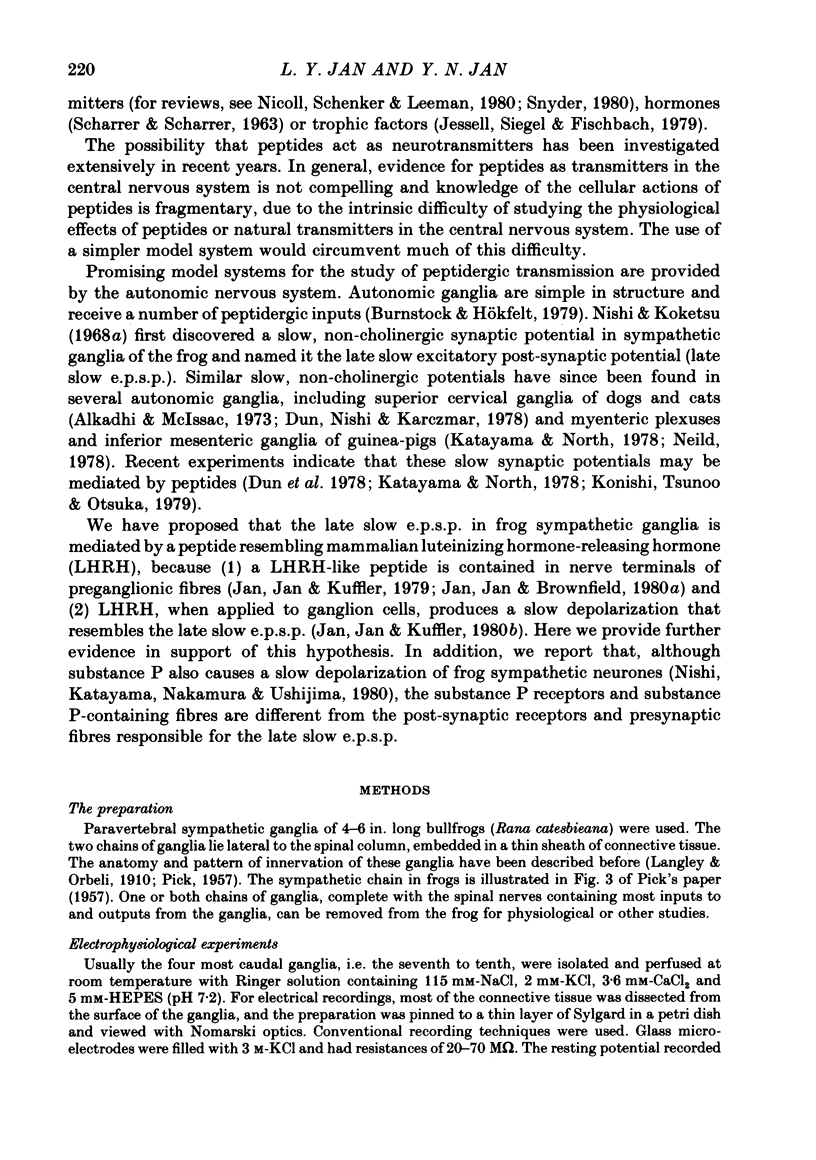
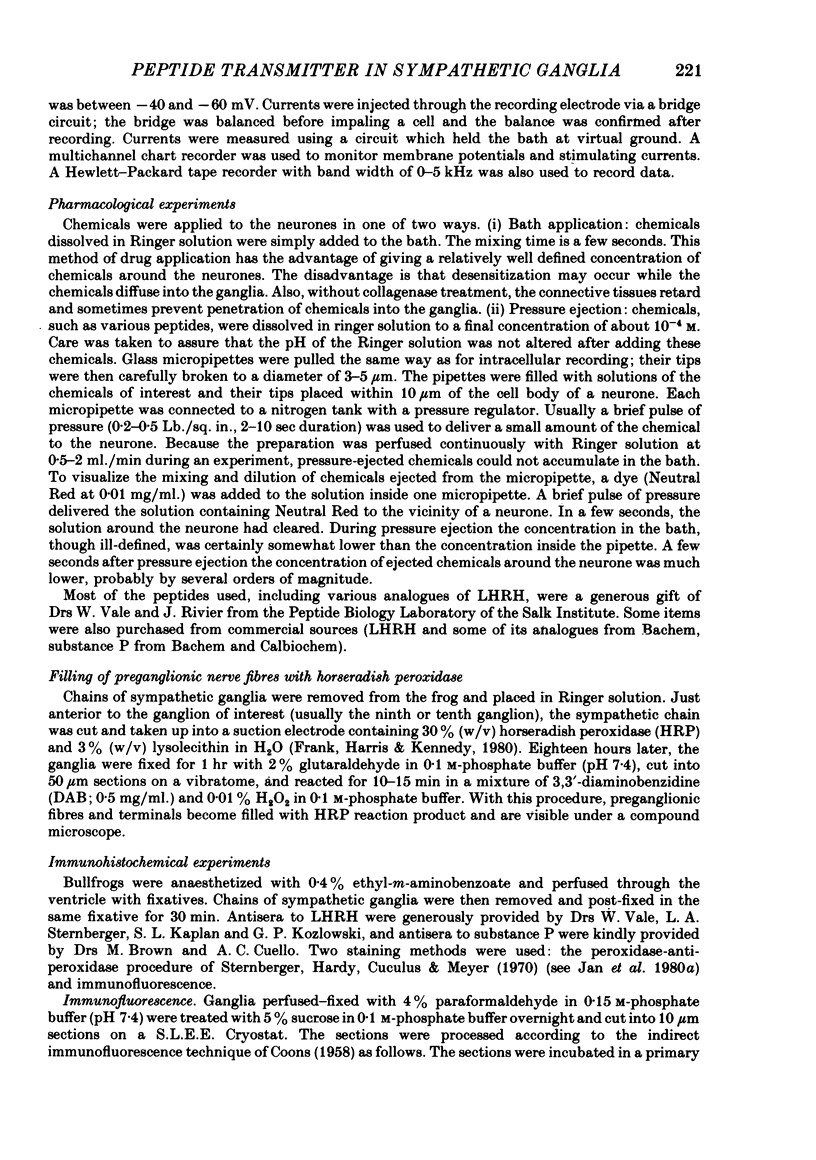
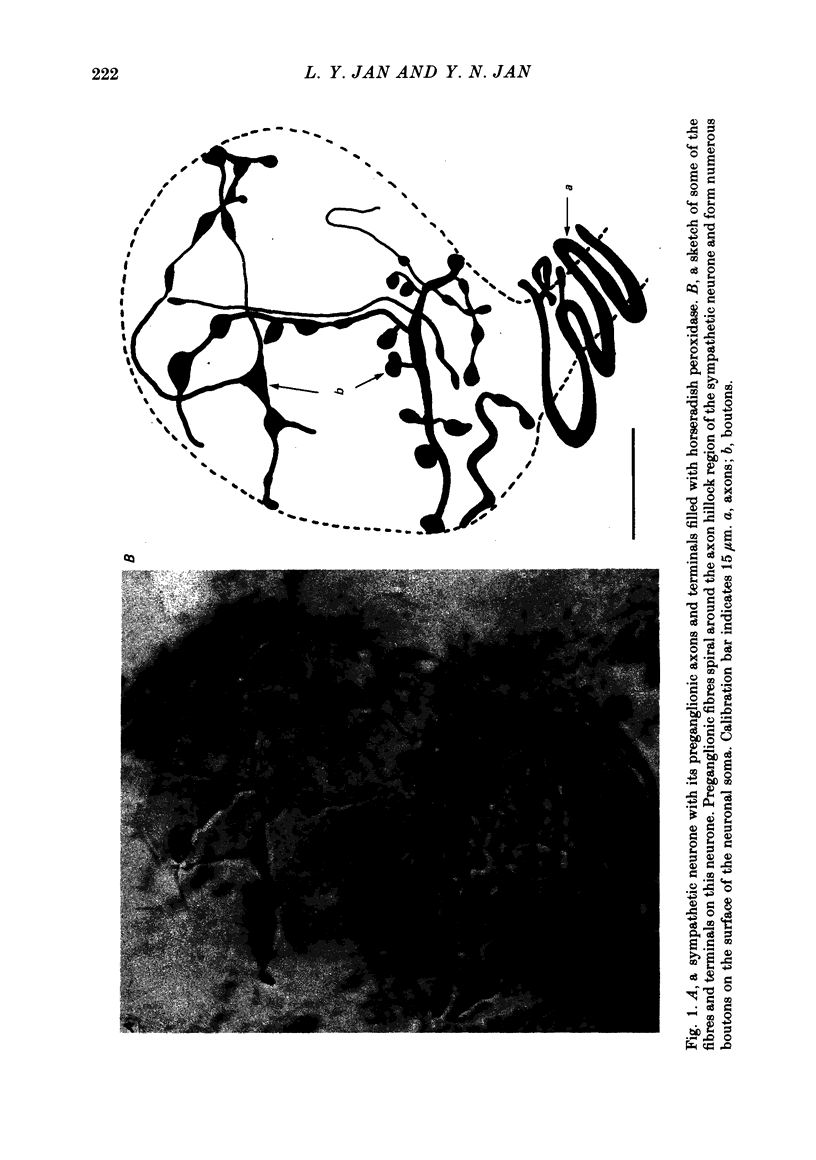
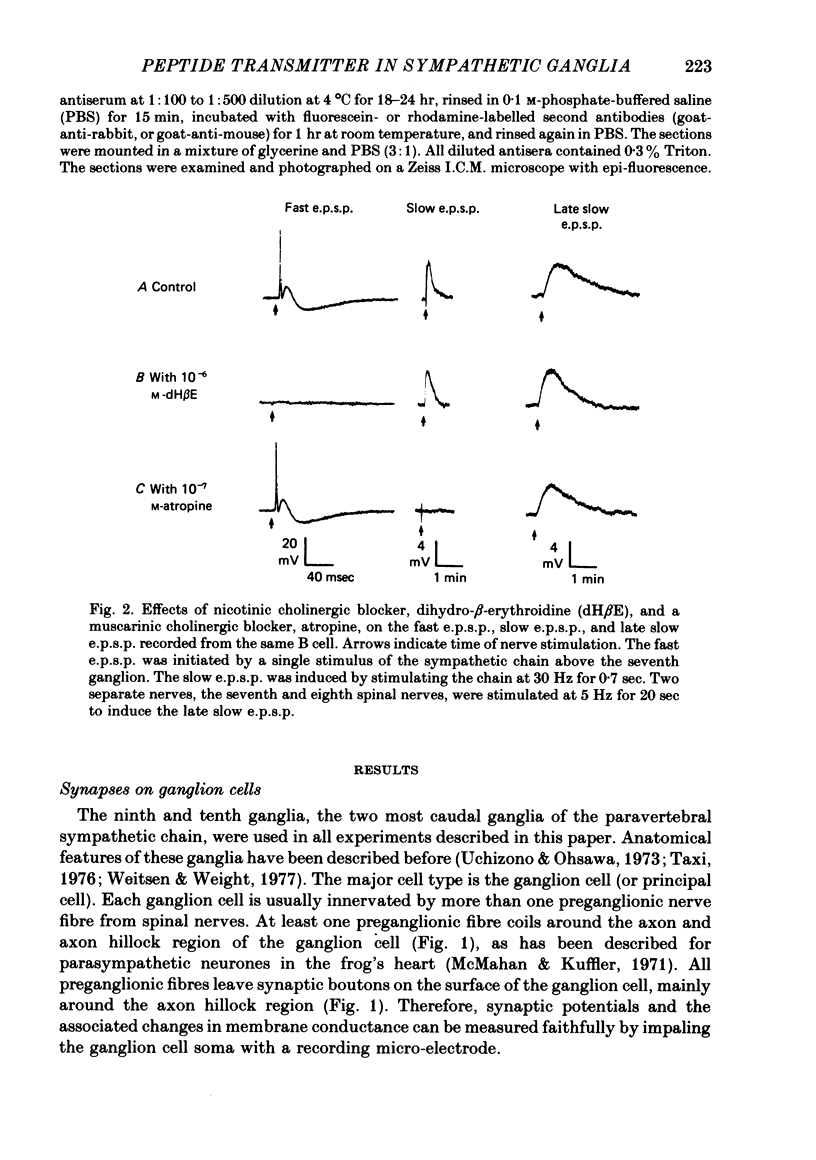
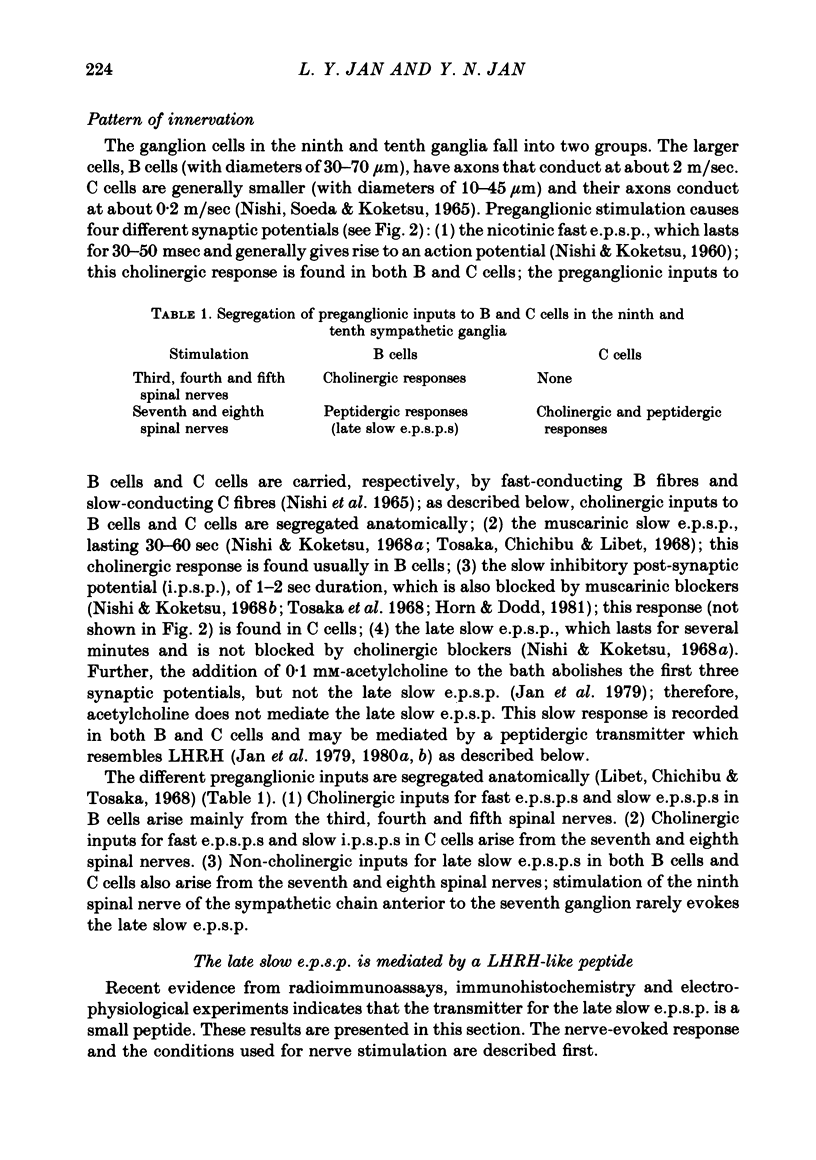
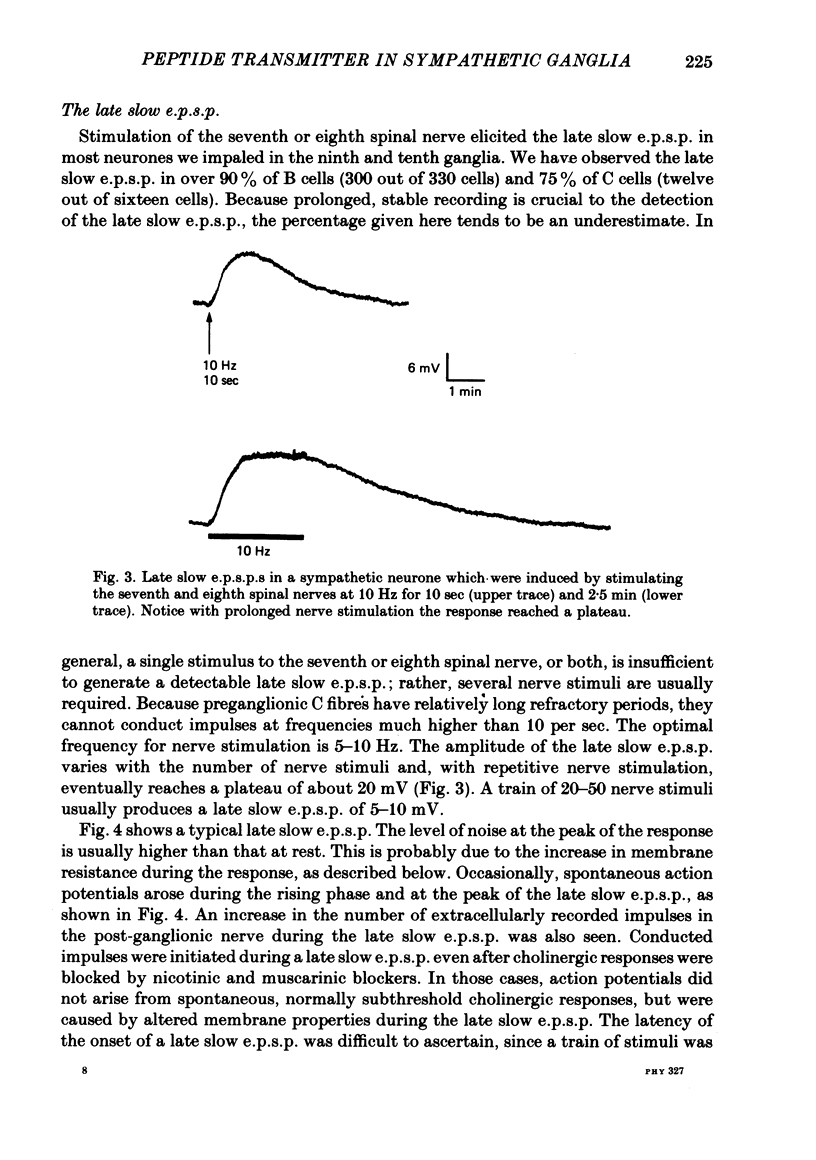
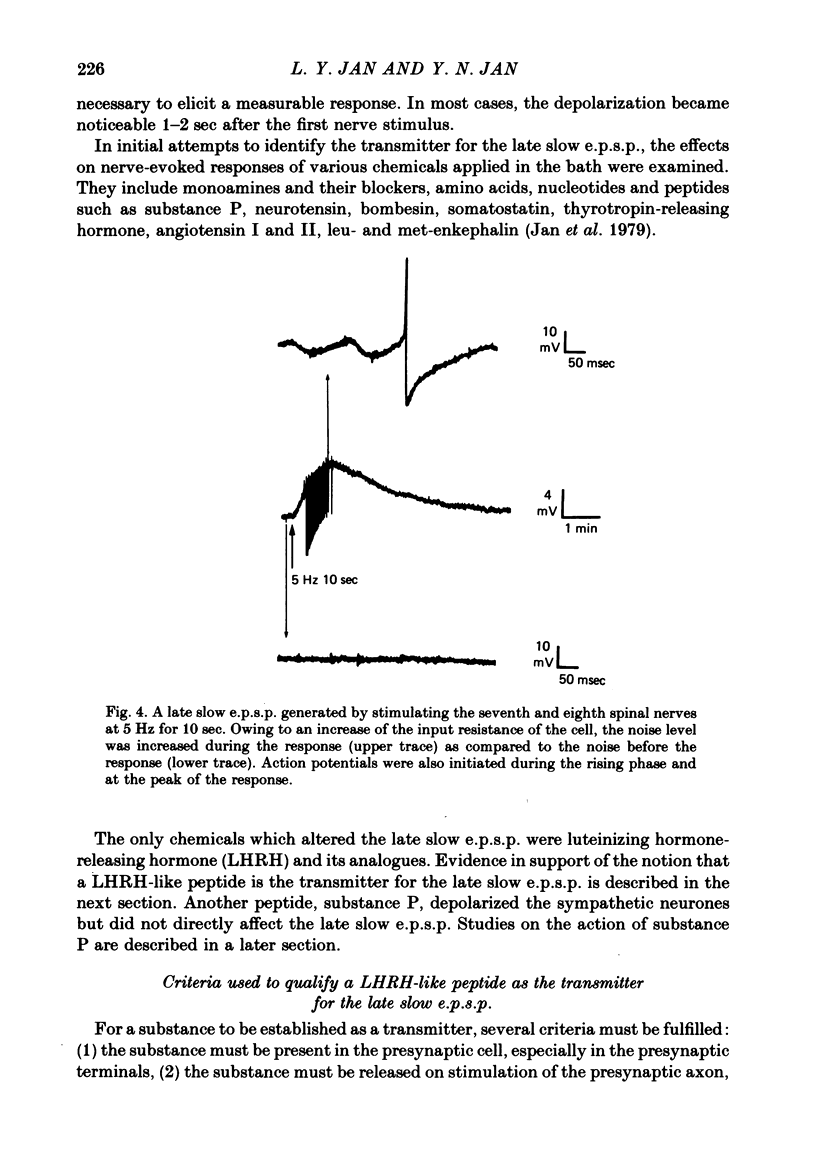
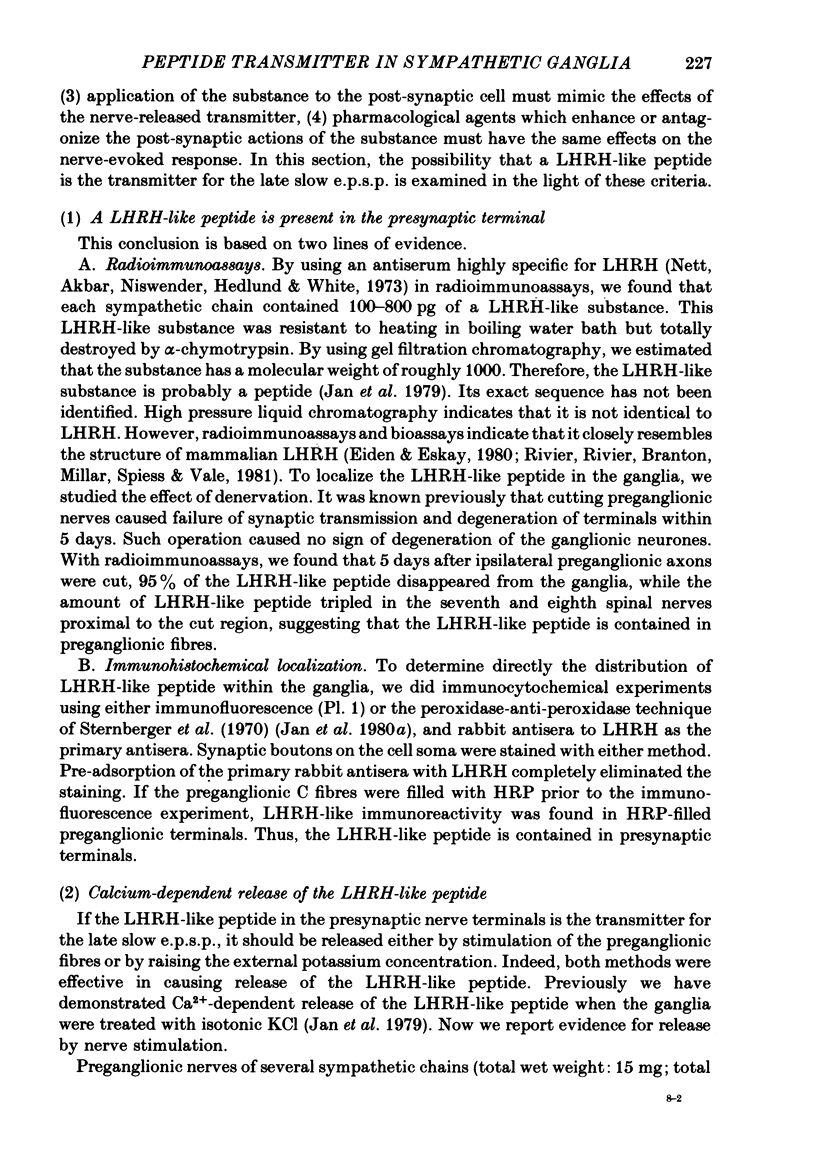
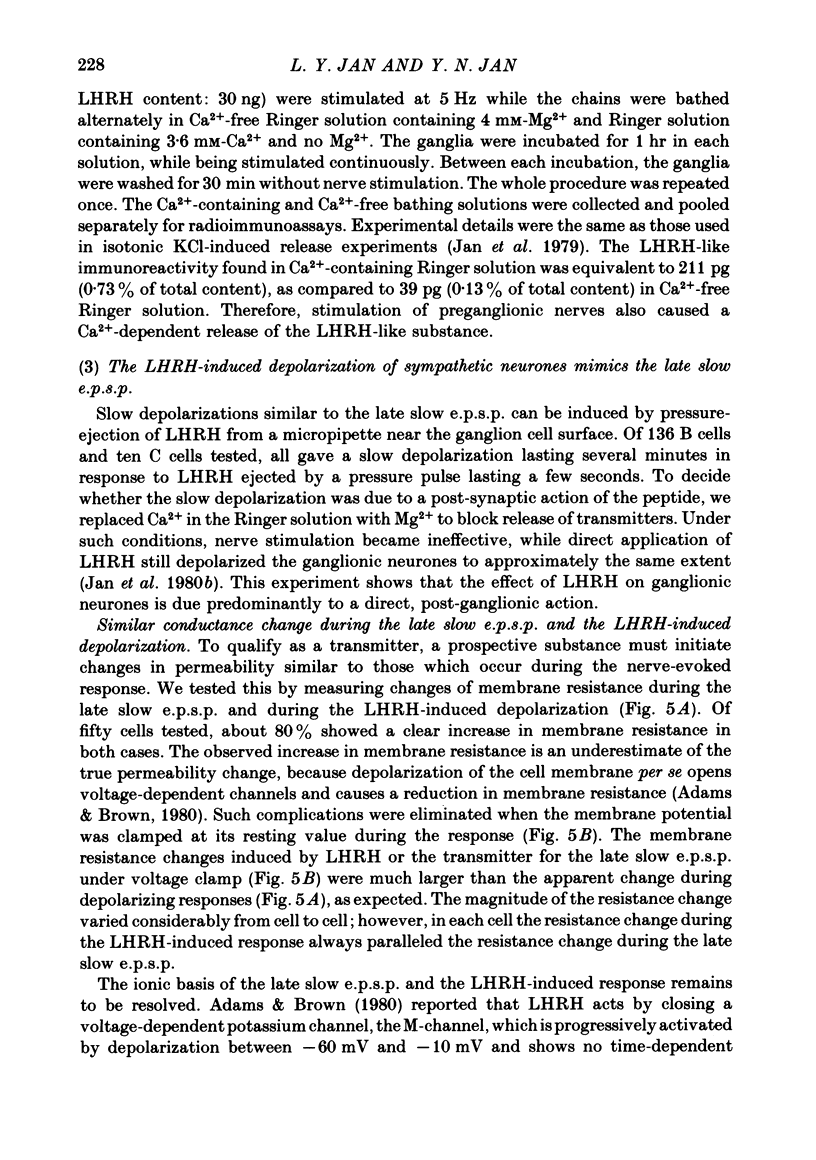
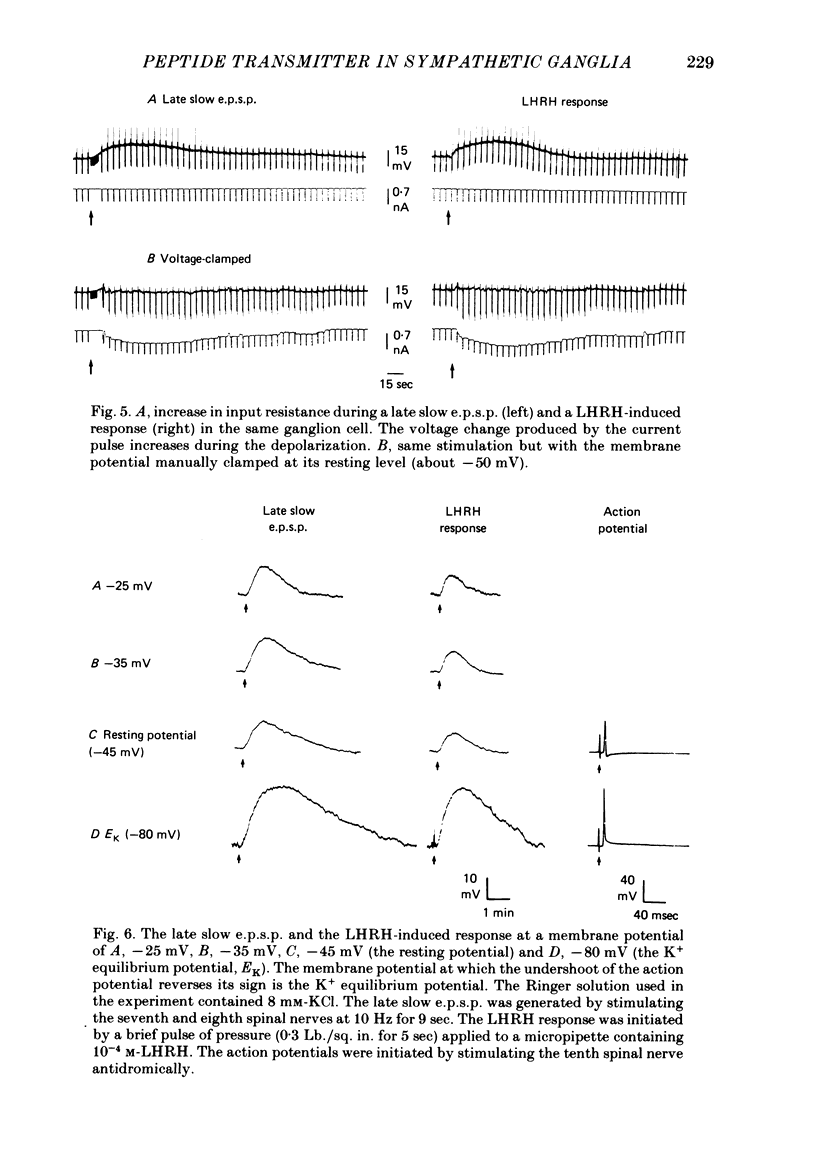
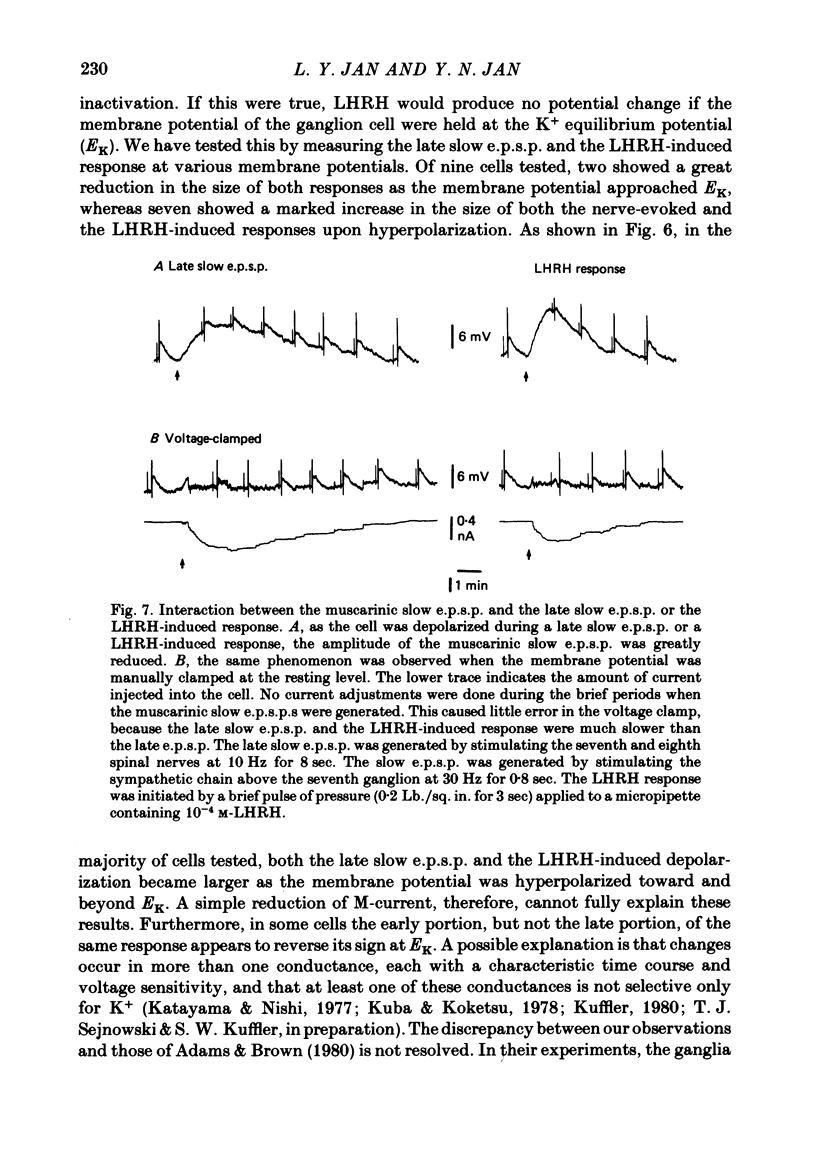
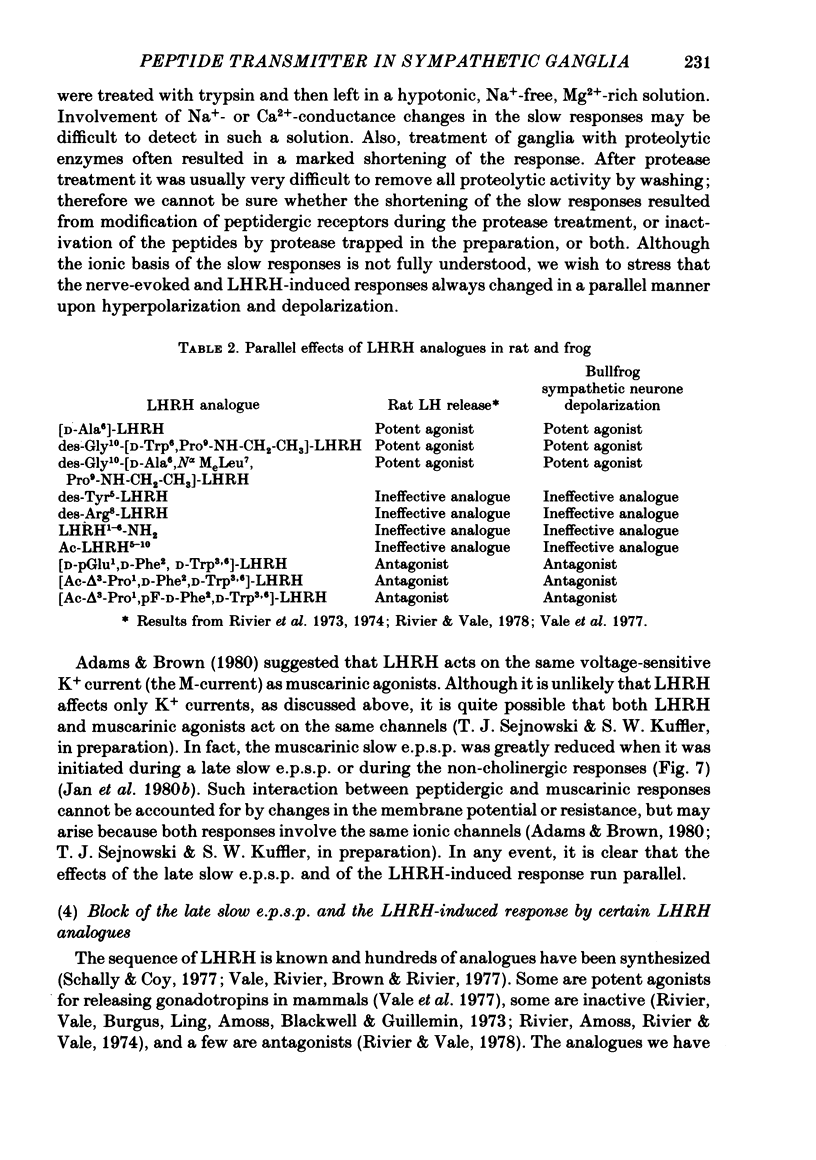
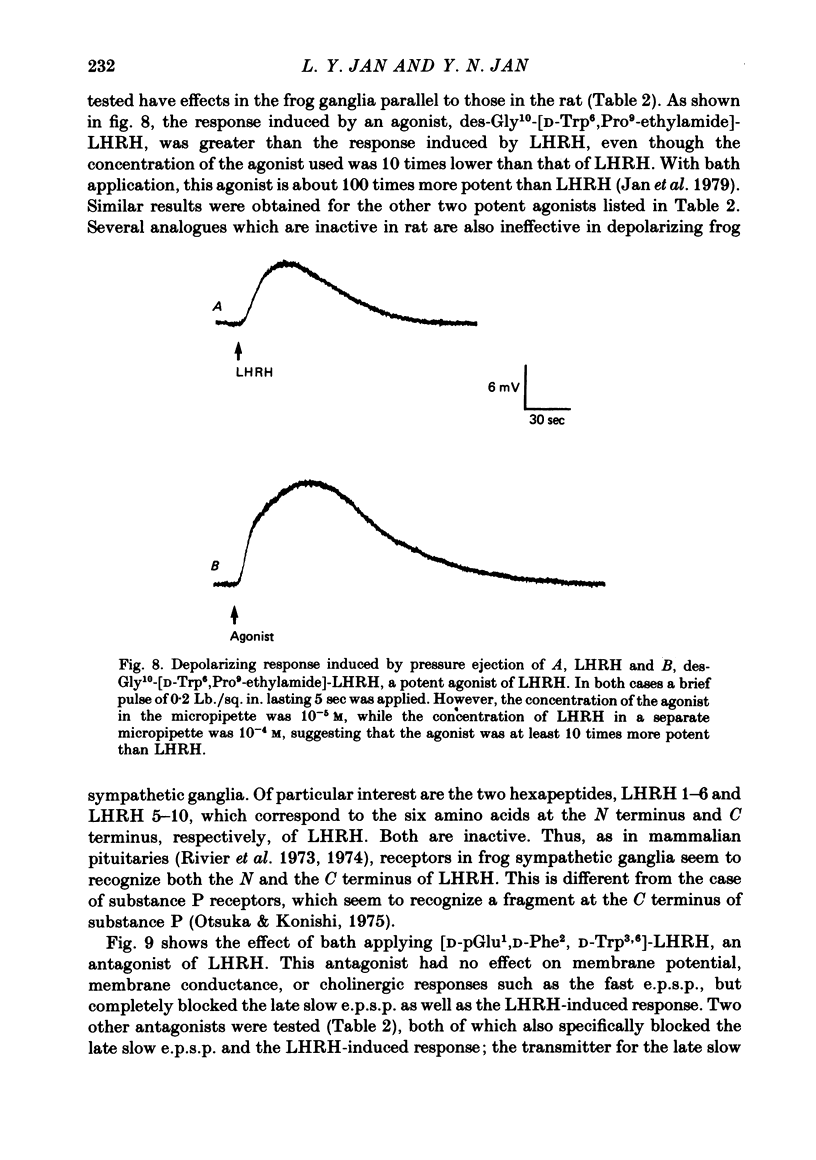
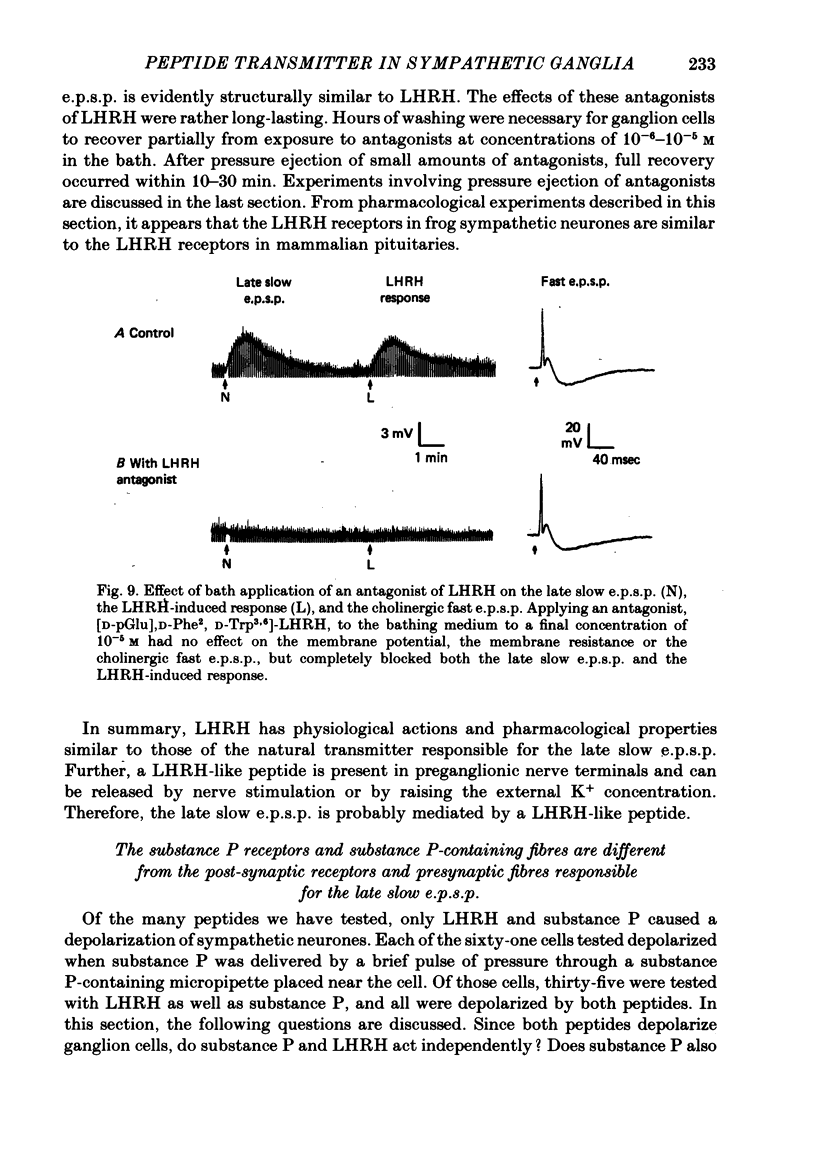
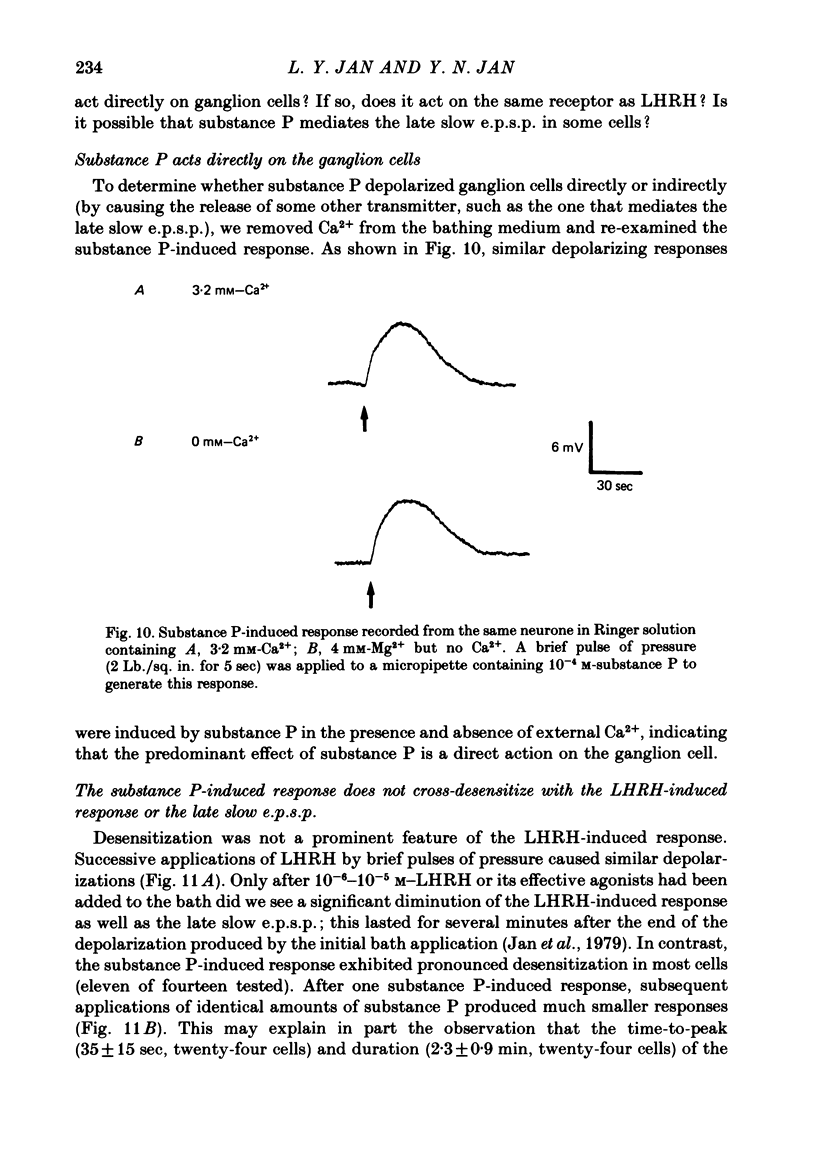

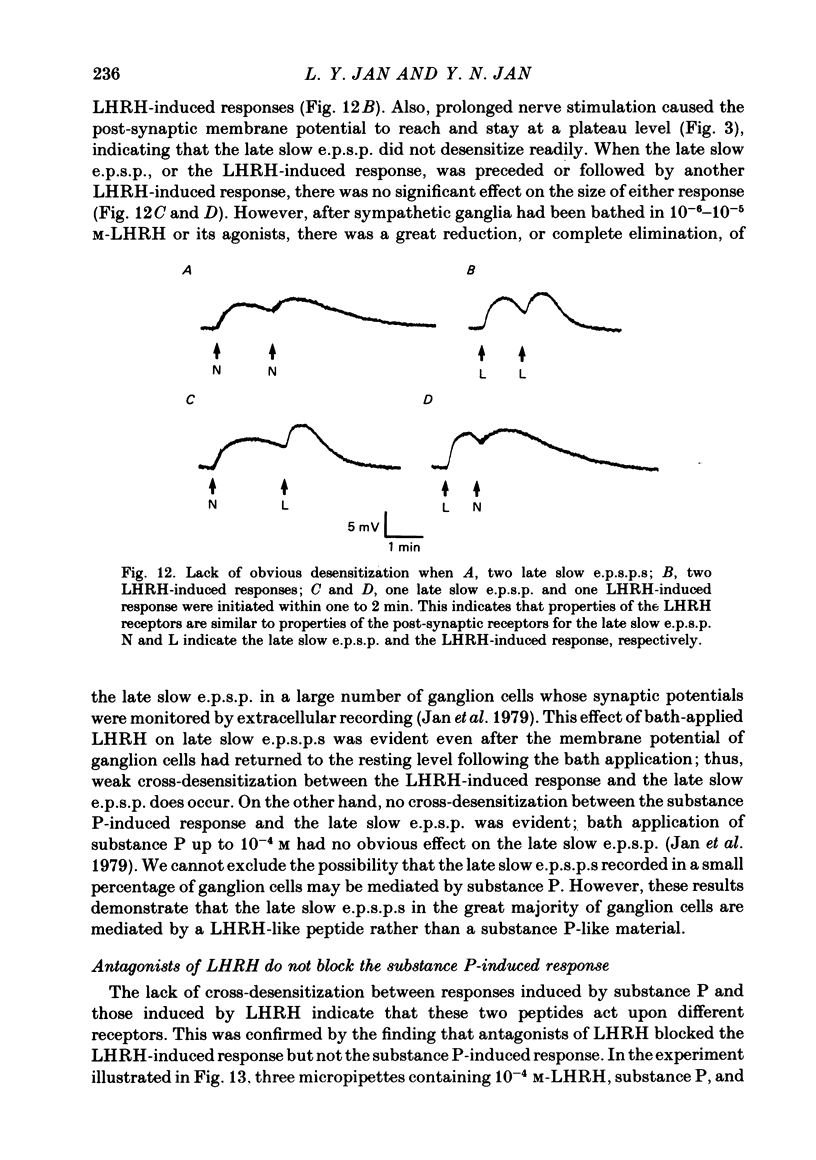
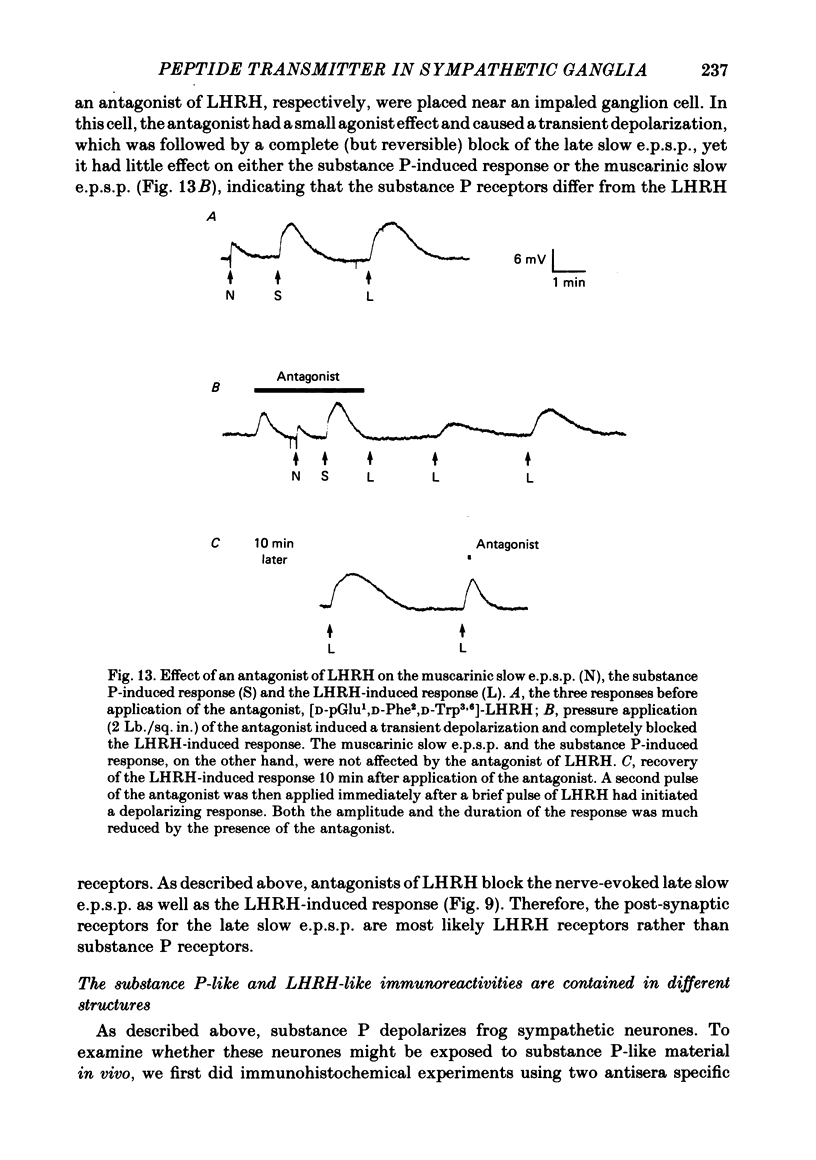
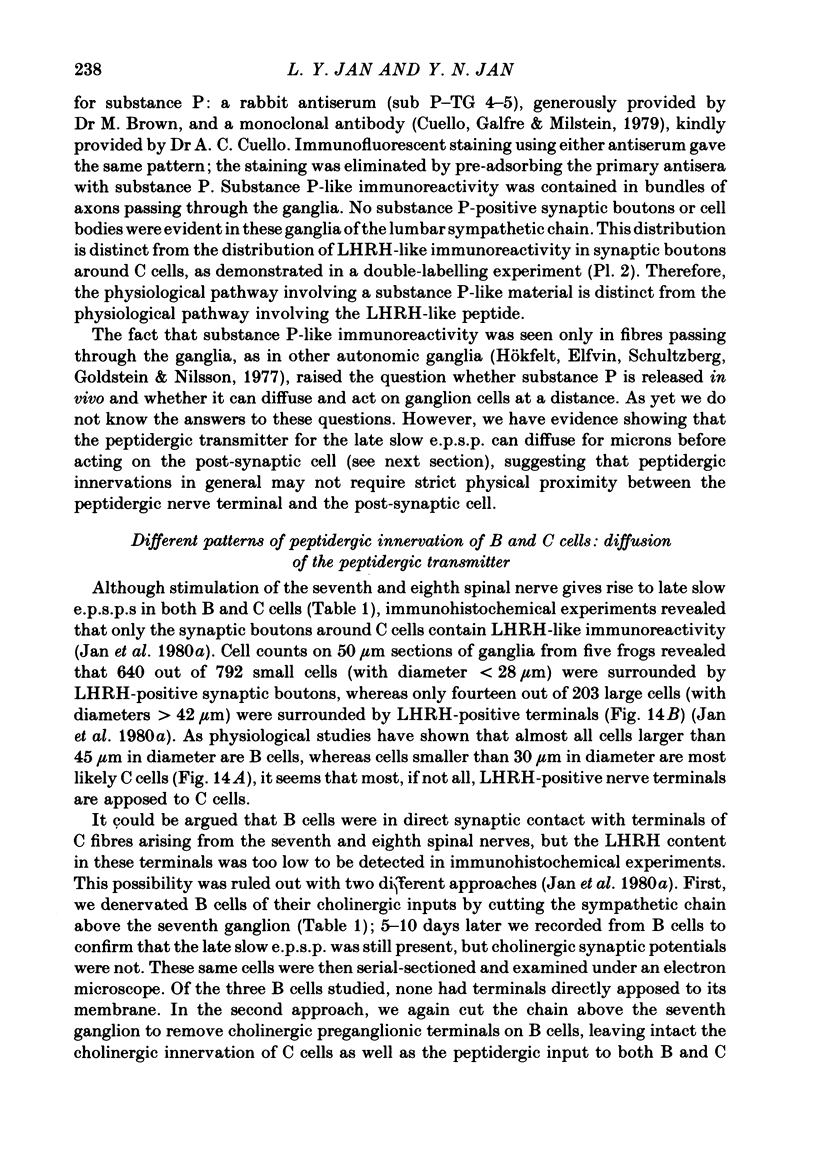
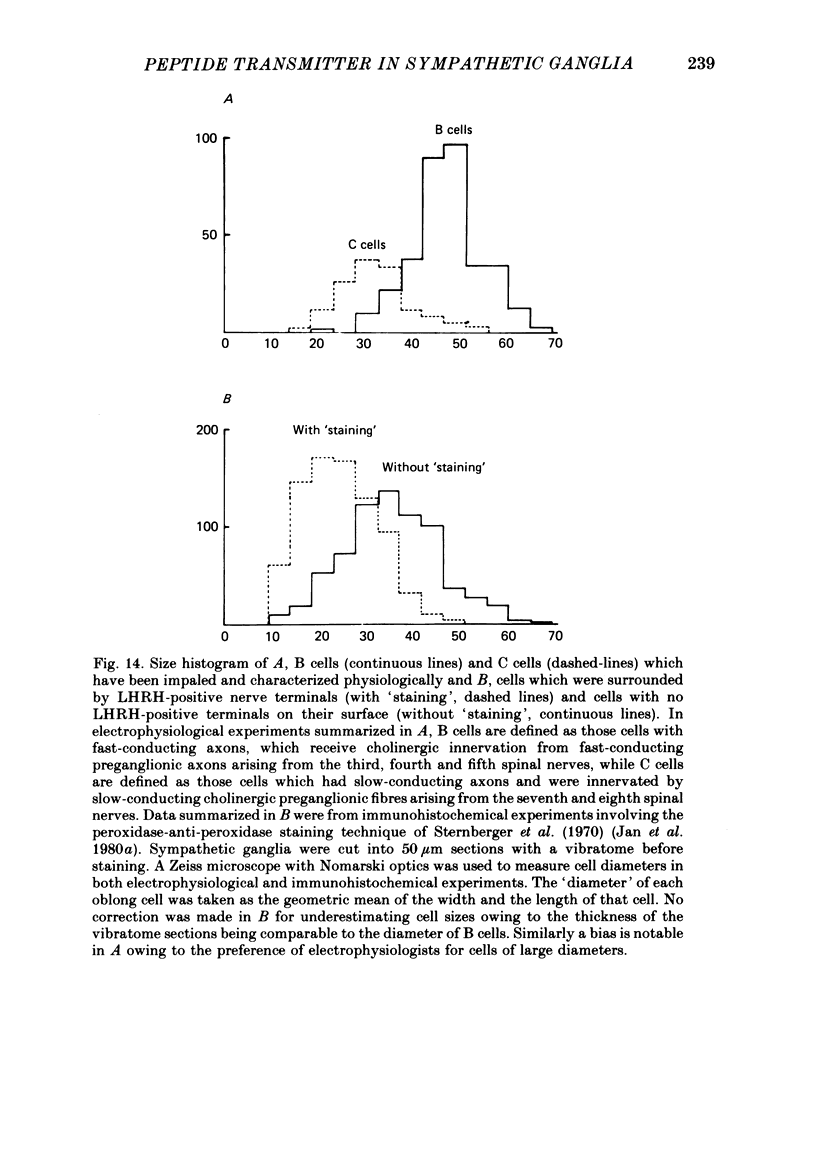
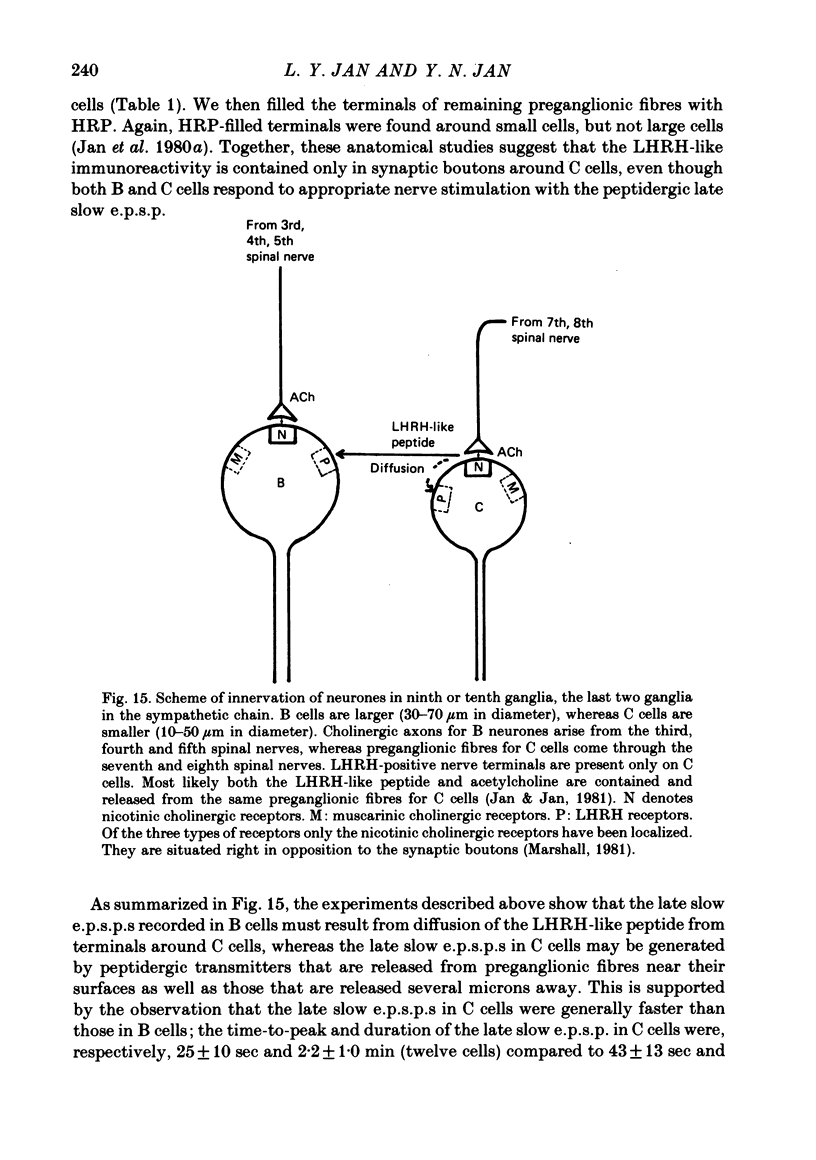
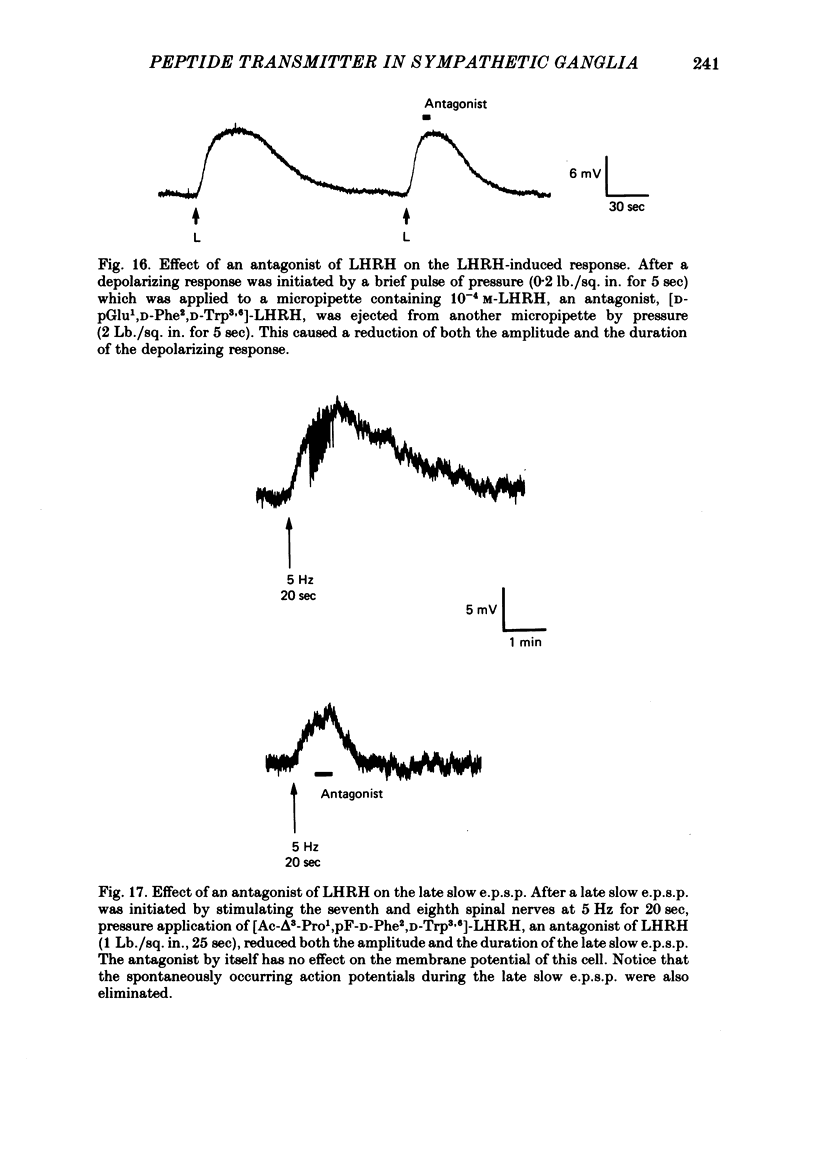
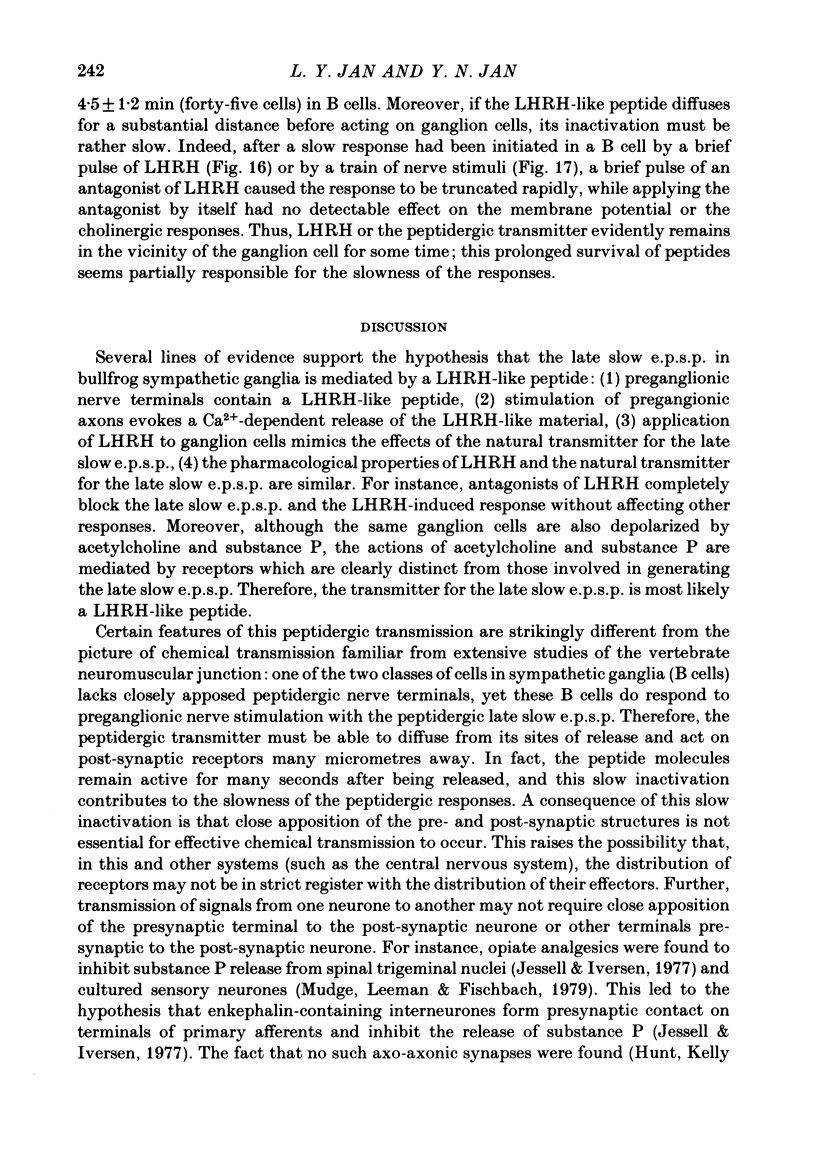
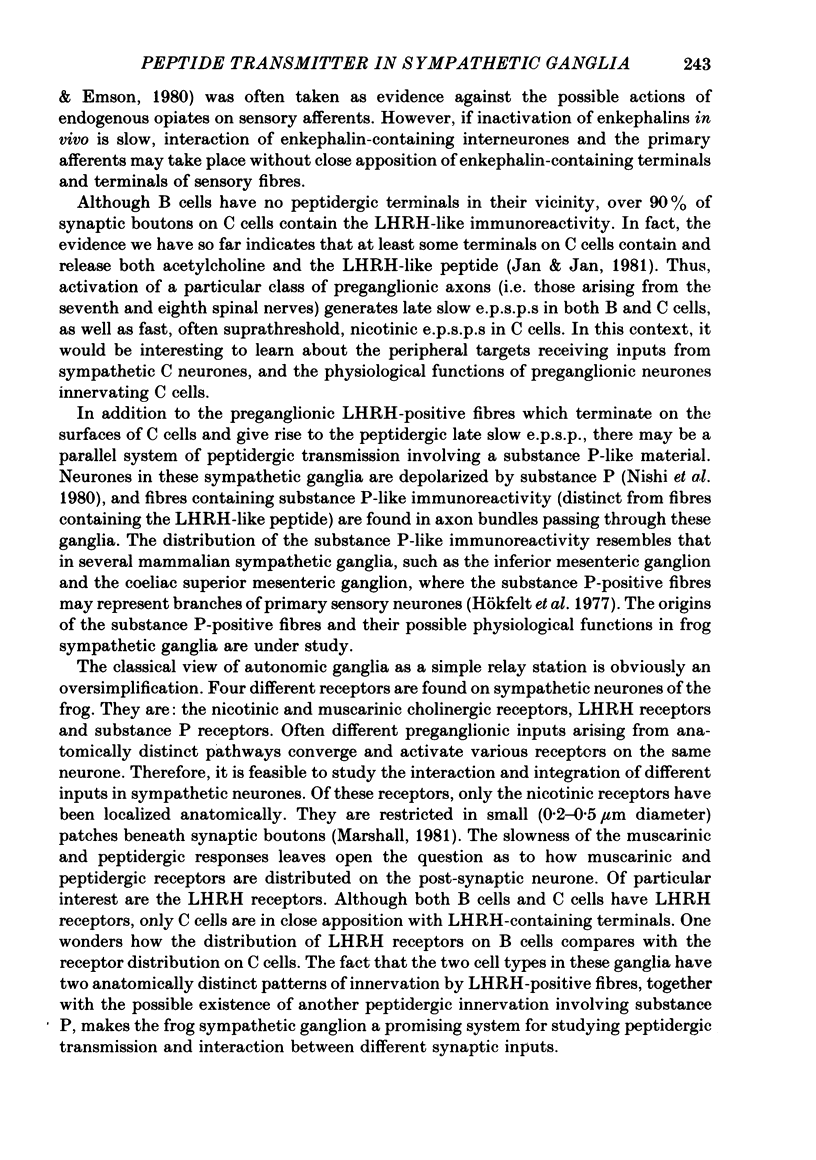
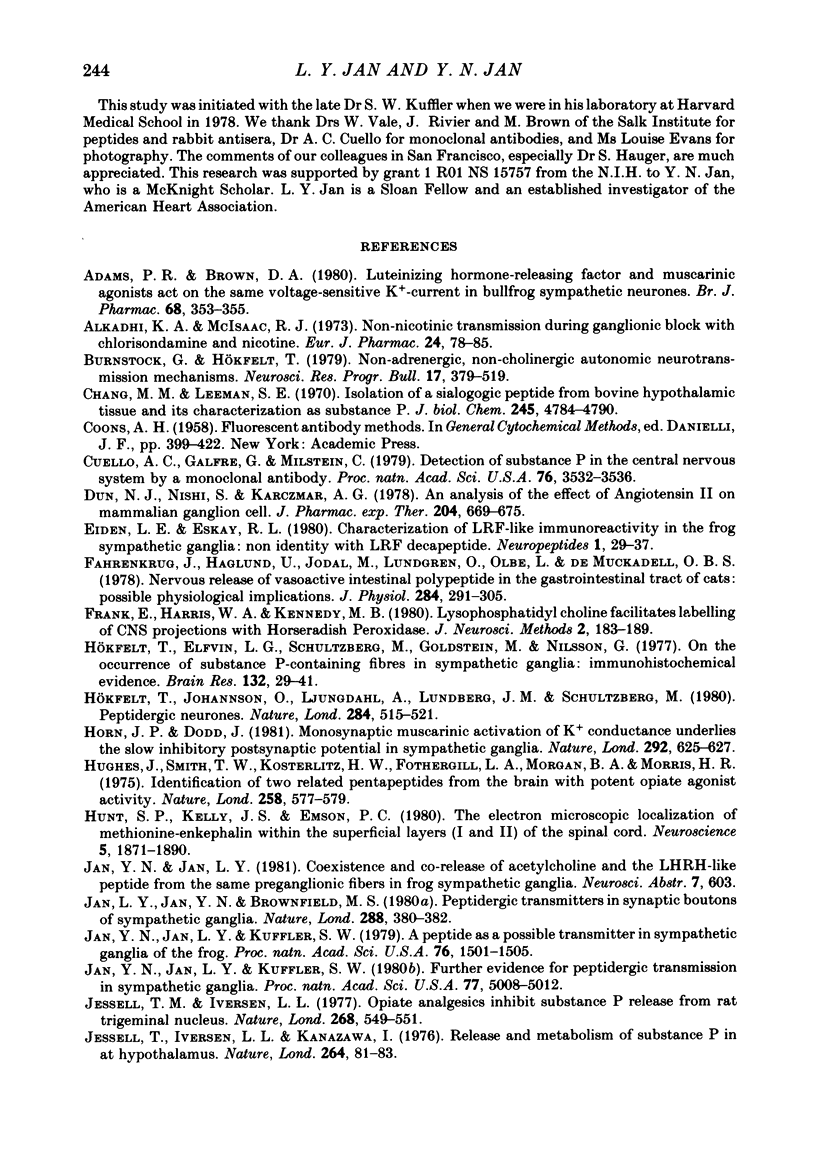
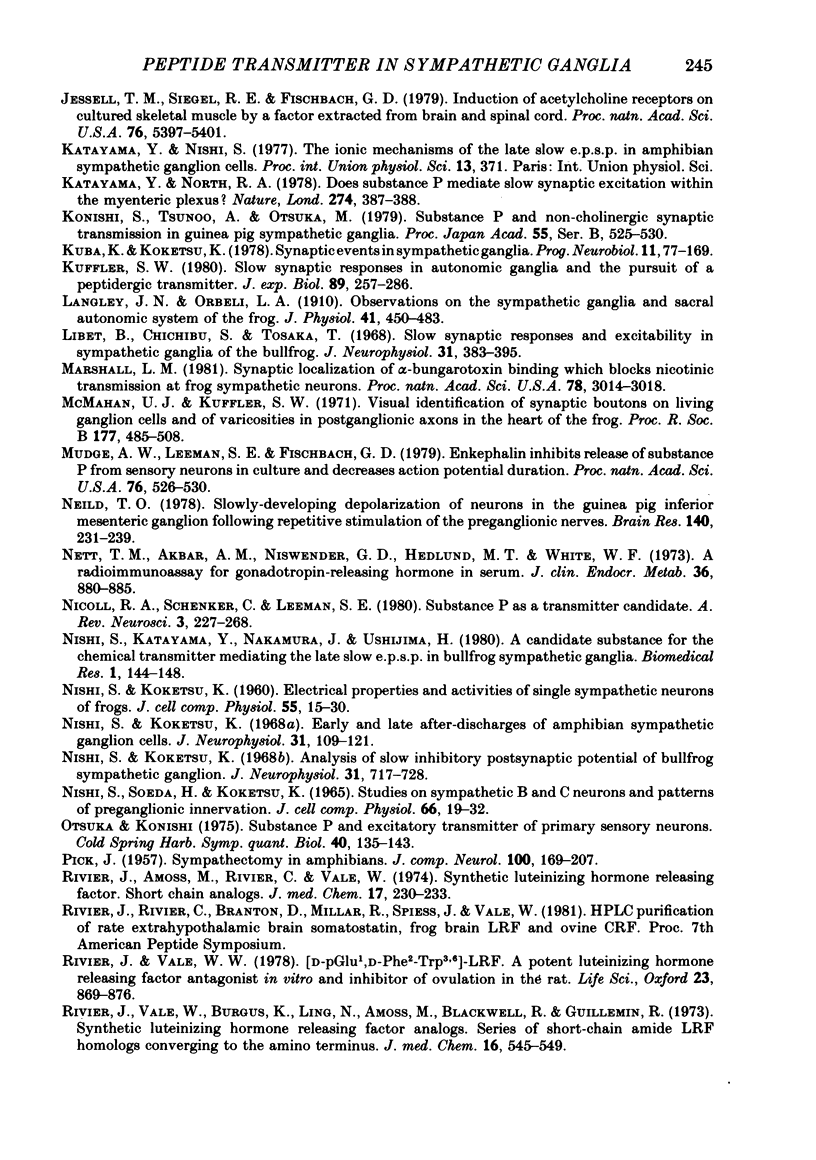
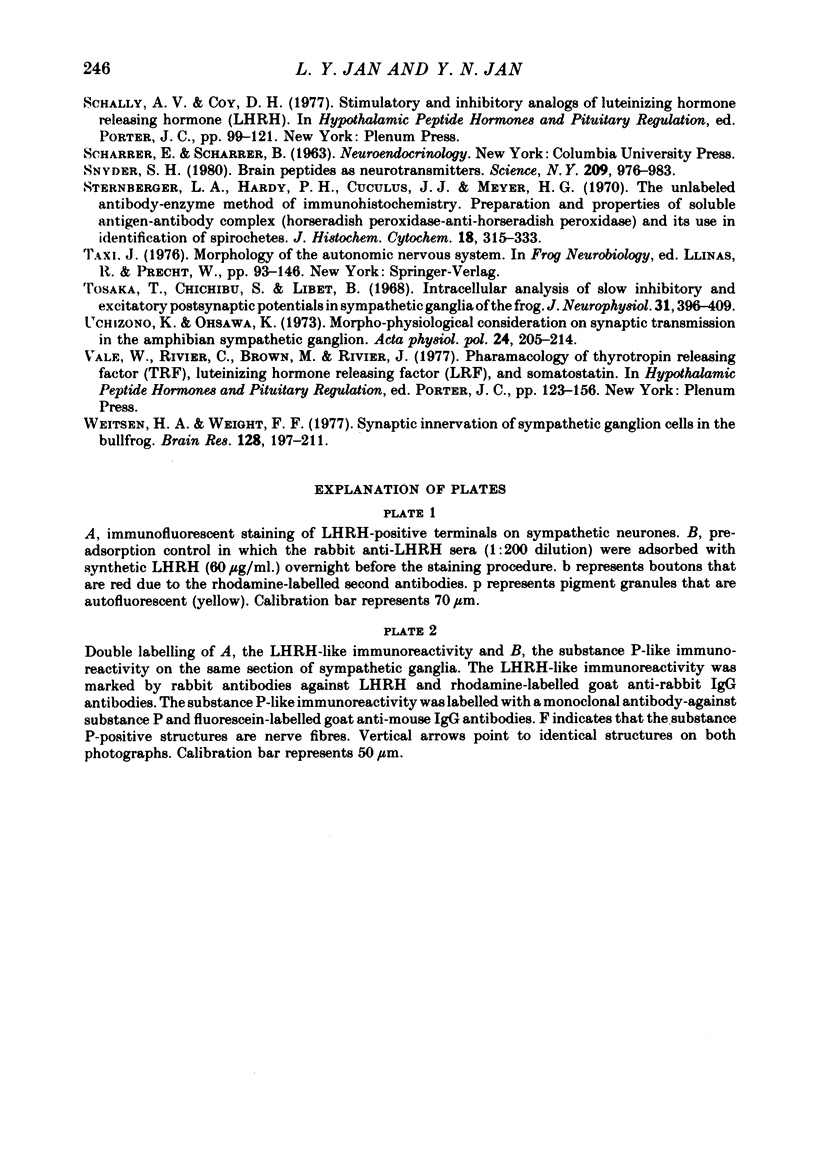
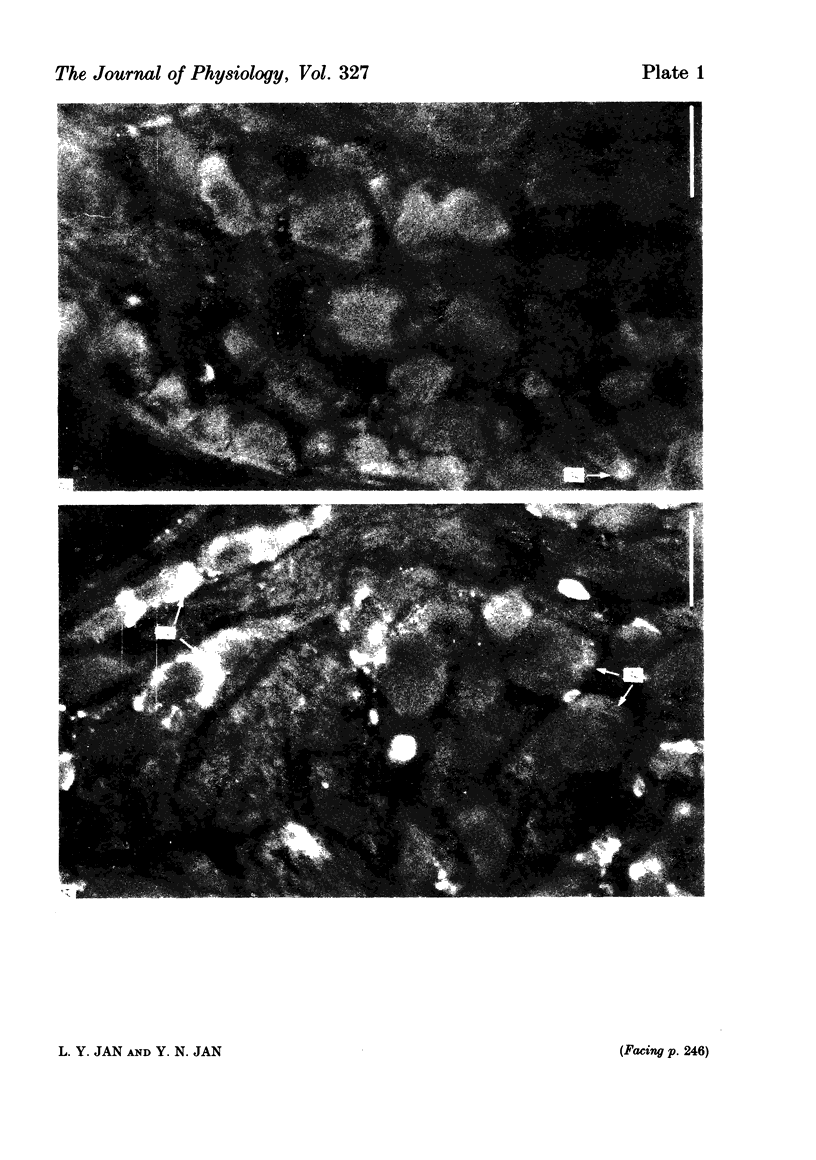
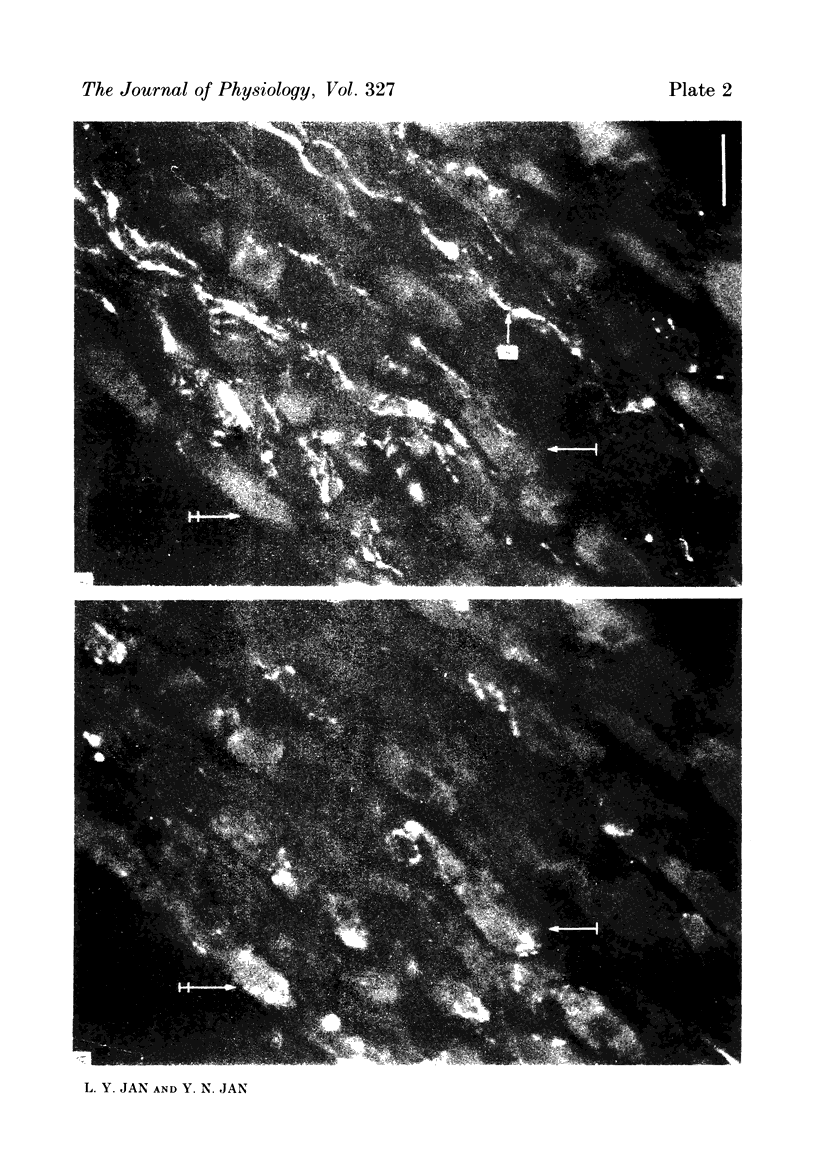
Images in this article
Selected References
These references are in PubMed. This may not be the complete list of references from this article.
- Adams P. R., Brown D. A. Luteinizing hormone-releasing factor and muscarinic agonists act on the same voltage-sensitive K+-current in bullfrog sympathetic neurones. Br J Pharmacol. 1980 Mar;68(3):353–355. doi: 10.1111/j.1476-5381.1980.tb14547.x. [DOI] [PMC free article] [PubMed] [Google Scholar]
- Alkadhi K. A., McIsaac R. J. Non-nicotinic transmission during ganglionic block with chlorisondamine and nicotine. Eur J Pharmacol. 1973 Oct;24(1):78–85. doi: 10.1016/0014-2999(73)90116-7. [DOI] [PubMed] [Google Scholar]
- Burnstock G., Hökfelt T., Gershon M. D., Iversen L. L., Kosterlitz H. W., Szurszewski J. H. Non-adrenergic, non-cholinergic autonomic neurotransmission mechanisms. Neurosci Res Program Bull. 1979 Jun;17(3):377–519. [PubMed] [Google Scholar]
- COONS A. H. Fluorescent antibody methods. Gen Cytochem Methods. 1958;1:399–422. [PubMed] [Google Scholar]
- Chang M. M., Leeman S. E. Isolation of a sialogogic peptide from bovine hypothalamic tissue and its characterization as substance P. J Biol Chem. 1970 Sep 25;245(18):4784–4790. [PubMed] [Google Scholar]
- Cuello A. C., Galfre G., Milstein C. Detection of substance P in the central nervous system by a monoclonal antibody. Proc Natl Acad Sci U S A. 1979 Jul;76(7):3532–3536. doi: 10.1073/pnas.76.7.3532. [DOI] [PMC free article] [PubMed] [Google Scholar]
- Dun N. J., Nishi S., Karczmar A. G. An analysis of the effect of angiotensin II on mammalian ganglion cells. J Pharmacol Exp Ther. 1978 Mar;204(3):669–675. [PubMed] [Google Scholar]
- Fahrenkrug J., Haglund U., Jodal M., Lundgren O., Olbe L., de Muckadell O. B. Nervous release of vasoactive intestinal polypeptide in the gastrointestinal tract of cats: possible physiological implications. J Physiol. 1978 Nov;284:291–305. doi: 10.1113/jphysiol.1978.sp012541. [DOI] [PMC free article] [PubMed] [Google Scholar]
- Frank E., Harris W. A., Kennedy M. B. Lysophosphatidyl choline facilitates labeling of CNS projections with horseradish peroxidase. J Neurosci Methods. 1980 Apr;2(2):183–189. doi: 10.1016/0165-0270(80)90059-x. [DOI] [PubMed] [Google Scholar]
- Horn J. P., Dodd J. Monosynaptic muscarinic activation of K+ conductance underlies the slow inhibitory postsynaptic potential in sympathetic ganglia. Nature. 1981 Aug 13;292(5824):625–627. doi: 10.1038/292625a0. [DOI] [PubMed] [Google Scholar]
- Hughes J., Smith T. W., Kosterlitz H. W., Fothergill L. A., Morgan B. A., Morris H. R. Identification of two related pentapeptides from the brain with potent opiate agonist activity. Nature. 1975 Dec 18;258(5536):577–580. doi: 10.1038/258577a0. [DOI] [PubMed] [Google Scholar]
- Hunt S. P., Kelly J. S., Emson P. C. The electron microscopic localization of methionine-enkephalin within the superficial layers (I and II) of the spinal cord. Neuroscience. 1980;5(11):1871–1890. doi: 10.1016/0306-4522(80)90036-6. [DOI] [PubMed] [Google Scholar]
- Hökfelt T., Elfvin L. G., Schultzberg M., Goldstein M., Nilsson G. On the occurrence of substance P-containing fibers in sympathetic ganglia: immunohistochemical evidence. Brain Res. 1977 Aug 19;132(1):29–41. doi: 10.1016/0006-8993(77)90704-1. [DOI] [PubMed] [Google Scholar]
- Hökfelt T., Johansson O., Ljungdahl A., Lundberg J. M., Schultzberg M. Peptidergic neurones. Nature. 1980 Apr 10;284(5756):515–521. doi: 10.1038/284515a0. [DOI] [PubMed] [Google Scholar]
- Iversen L. L., Jessell T., Kanazawa I. Release and metabolism of substance P in rat hypothalamus. Nature. 1976 Nov 4;264(5581):81–83. doi: 10.1038/264081a0. [DOI] [PubMed] [Google Scholar]
- Jan L. Y., Jan Y. N., Brownfield M. S. Peptidergic transmitters in synaptic boutons of sympathetic ganglia. Nature. 1980 Nov 27;288(5789):380–382. doi: 10.1038/288380a0. [DOI] [PubMed] [Google Scholar]
- Jan Y. N., Jan L. Y., Kuffler S. W. A peptide as a possible transmitter in sympathetic ganglia of the frog. Proc Natl Acad Sci U S A. 1979 Mar;76(3):1501–1505. doi: 10.1073/pnas.76.3.1501. [DOI] [PMC free article] [PubMed] [Google Scholar]
- Jan Y. N., Jan L. Y., Kuffler S. W. Further evidence for peptidergic transmission in sympathetic ganglia. Proc Natl Acad Sci U S A. 1980 Aug;77(8):5008–5012. doi: 10.1073/pnas.77.8.5008. [DOI] [PMC free article] [PubMed] [Google Scholar]
- Jessell T. M., Iversen L. L. Opiate analgesics inhibit substance P release from rat trigeminal nucleus. Nature. 1977 Aug 11;268(5620):549–551. doi: 10.1038/268549a0. [DOI] [PubMed] [Google Scholar]
- Jessell T. M., Siegel R. E., Fischbach G. D. Induction of acetylcholine receptors on cultured skeletal muscle by a factor extracted from brain and spinal cord. Proc Natl Acad Sci U S A. 1979 Oct;76(10):5397–5401. doi: 10.1073/pnas.76.10.5397. [DOI] [PMC free article] [PubMed] [Google Scholar]
- Katayama Y., North R. A. Does substance P mediate slow synaptic excitation within the myenteric plexus? Nature. 1978 Jul 27;274(5669):387–388. doi: 10.1038/274387a0. [DOI] [PubMed] [Google Scholar]
- Kuba K., Koketsu K. Synaptic events in sympathetic ganglia. Prog Neurobiol. 1978;11(2):77–169. doi: 10.1016/0301-0082(78)90010-2. [DOI] [PubMed] [Google Scholar]
- Kuffler S. W. Slow synaptic responses in autonomic ganglia and the pursuit of a peptidergic transmitter. J Exp Biol. 1980 Dec;89:257–286. doi: 10.1242/jeb.89.1.257. [DOI] [PubMed] [Google Scholar]
- Langley J. N., Orbeli L. A. Observations on the sympathetic and sacral autonomic system of the frog. J Physiol. 1910 Dec 31;41(5):450–482. doi: 10.1113/jphysiol.1910.sp001412. [DOI] [PMC free article] [PubMed] [Google Scholar]
- Libet B., Chichibu S., Tosaka T. Slow synaptic responses and excitability in sympathetic ganglia of the bullfrog. J Neurophysiol. 1968 May;31(3):383–395. doi: 10.1152/jn.1968.31.3.383. [DOI] [PubMed] [Google Scholar]
- McMahan U. J., Kuffler S. W. Visual identification of synaptic boutons on living ganglion cells and of varicosities in postganglionic axons in the heart of the frog. Proc R Soc Lond B Biol Sci. 1971 Apr 27;177(1049):485–508. doi: 10.1098/rspb.1971.0044. [DOI] [PubMed] [Google Scholar]
- Mudge A. W., Leeman S. E., Fischbach G. D. Enkephalin inhibits release of substance P from sensory neurons in culture and decreases action potential duration. Proc Natl Acad Sci U S A. 1979 Jan;76(1):526–530. doi: 10.1073/pnas.76.1.526. [DOI] [PMC free article] [PubMed] [Google Scholar]
- NISHI S., KOKETSU K. Electrical properties and activities of single sympathetic neurons in frogs. J Cell Comp Physiol. 1960 Feb;55:15–30. doi: 10.1002/jcp.1030550104. [DOI] [PubMed] [Google Scholar]
- Neild T. O. Slowly-developing depolarization of neurones in the guinea-pig inferior mesenteric ganglion following repetitive stimulation of the preganglionic nerves. Brain Res. 1978 Jan 27;140(2):231–239. doi: 10.1016/0006-8993(78)90457-2. [DOI] [PubMed] [Google Scholar]
- Nett T. M., Akbar A. M., Niswender G. D., Hedlund M. T., White W. F. A radioimmunoassay for gonadotropin-releasing hormone (Gn-RH) in serum. J Clin Endocrinol Metab. 1973 May;36(5):880–885. doi: 10.1210/jcem-36-5-880. [DOI] [PubMed] [Google Scholar]
- Nicoll R. A., Schenker C., Leeman S. E. Substance P as a transmitter candidate. Annu Rev Neurosci. 1980;3:227–268. doi: 10.1146/annurev.ne.03.030180.001303. [DOI] [PubMed] [Google Scholar]
- Nishi S., Koketsu K. Analysis of slow inhibitory postsynaptic potential of bullfrog sympathetic ganglion. J Neurophysiol. 1968 Sep;31(5):717–728. doi: 10.1152/jn.1968.31.5.717. [DOI] [PubMed] [Google Scholar]
- Nishi S., Koketsu K. Early and late after discharges of amphibian sympathetic ganglion cells. J Neurophysiol. 1968 Jan;31(1):109–121. doi: 10.1152/jn.1968.31.1.109. [DOI] [PubMed] [Google Scholar]
- Nishi S., Soeda H., Koketsu K. Studies on sympathetic B and C neurons and patterns of pregnaglionic innervation. J Cell Physiol. 1965 Aug;66(1):19–32. doi: 10.1002/jcp.1030660103. [DOI] [PubMed] [Google Scholar]
- Otsuka M., Konishi S. Substance P and excitatory transmitter of primary sensory neurons. Cold Spring Harb Symp Quant Biol. 1976;40:135–143. doi: 10.1101/sqb.1976.040.01.015. [DOI] [PubMed] [Google Scholar]
- PICK J. Sympathectomy in amphibians; anatomical considerations. J Comp Neurol. 1957 Apr;107(2):169–207. doi: 10.1002/cne.901070202. [DOI] [PubMed] [Google Scholar]
- Rivier J. E., Vale W. W. [D-pGlu1,D-Phe2,D-Trp3,6]-LRF. A potent luteinizing hormone releasing factor antagonist in vitro and inhibitor of ovulation in the rat. Life Sci. 1978 Aug 28;23(8):869–876. doi: 10.1016/0024-3205(78)90522-2. [DOI] [PubMed] [Google Scholar]
- Rivier J., Amoss M., Rivier C., Vale W. Synthetic luteinizing hormone releasing factor. Short chain analogs. J Med Chem. 1974 Feb;17(2):230–233. doi: 10.1021/jm00248a019. [DOI] [PubMed] [Google Scholar]
- Rivier J., Vale W., Burgus R., Ling N., Amoss M., Blackwell R., Guillemin R. Synthetic luteinizing hormone-releasing factor analogs. Series of short-chain amide LRF homologs converging to the amino terminus. J Med Chem. 1973 May;16(5):545–549. doi: 10.1021/jm00263a031. [DOI] [PubMed] [Google Scholar]
- Schally A. V., Coy D. H. Stimulatory and inhibitory analogs of luteinizing hormone releasing hormone (LHRH). Adv Exp Med Biol. 1977;87:99–121. doi: 10.1007/978-1-4615-8849-8_6. [DOI] [PubMed] [Google Scholar]
- Snyder S. H. Brain peptides as neurotransmitters. Science. 1980 Aug 29;209(4460):976–983. doi: 10.1126/science.6157191. [DOI] [PubMed] [Google Scholar]
- Sternberger L. A., Hardy P. H., Jr, Cuculis J. J., Meyer H. G. The unlabeled antibody enzyme method of immunohistochemistry: preparation and properties of soluble antigen-antibody complex (horseradish peroxidase-antihorseradish peroxidase) and its use in identification of spirochetes. J Histochem Cytochem. 1970 May;18(5):315–333. doi: 10.1177/18.5.315. [DOI] [PubMed] [Google Scholar]
- Tosaka T., Chichibu S., Libet B. Intracellular analysis of slow inhibitors and excitatory postsynaptic potentials in sympathetic ganglia of the frog. J Neurophysiol. 1968 May;31(3):396–409. doi: 10.1152/jn.1968.31.3.396. [DOI] [PubMed] [Google Scholar]
- Uchizono K., Ohsawa K. Morpho-physiological consideration on synaptic transmission in the amphibian sympathetic ganglion. Acta Physiol Pol. 1973 Jan-Feb;24(1):205–214. [PubMed] [Google Scholar]
- Vale W., Rivier C., Brown M., Rivier J. Pharmacology of thyrotropin releasing factor (TRF), luteinizing hormone releasing factor (LRF), and somatostatin. Adv Exp Med Biol. 1977;87:123–156. doi: 10.1007/978-1-4615-8849-8_7. [DOI] [PubMed] [Google Scholar]
- Weitsen H. A., Weight F. F. Synaptic innervation of sympathetic ganglion cells in the bullfrog. Brain Res. 1977 Jun 10;128(2):197–211. doi: 10.1016/0006-8993(77)90988-x. [DOI] [PubMed] [Google Scholar]



